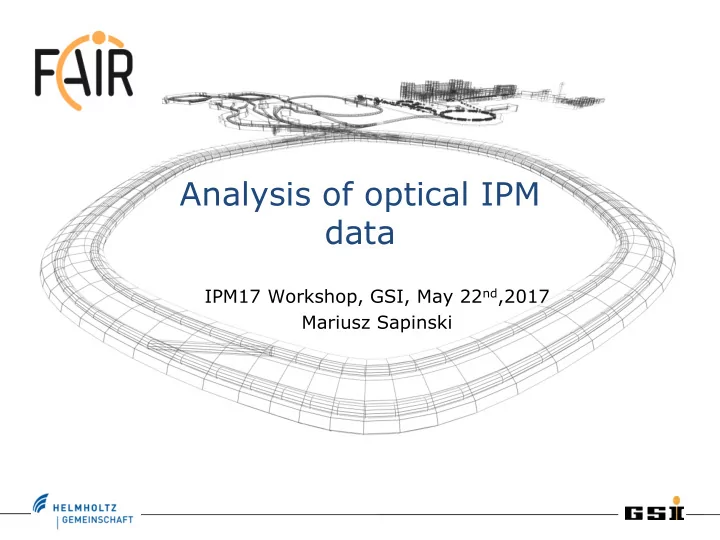

Analysis of optical IPM data IPM17 Workshop, GSI, May 22 nd ,2017 Mariusz Sapinski
Outlook • Motivation. • LHC IPM. • Features of 2D IPM image on example of LHC monitor. • Filtering in frequency domain. • Slicing 2D image – camera tilt correction. • Deconvolution of optical Point Spread Function (PSF). • Conclusions. 2
Motivation • Inability to calibrate LHC IPM (BGI) attributed to beam space-charge. • This leads to non-gaussian deformation of observed profiles. • Can we see this deformation in LHC data? • In other words: can we clean the data from other effects? The following examples are obtained using ROOT. After recent experiences I would rather recommend Python and numpy. 3
LHC IPM MCP ageing, phosphor screen burn-in Frame MCP resolution 32 μ m ion trap wires glowing grabber electron emission cone Noise on analog video signal beam space charge, electron cloud ~180 m CID camera E B beam (intensified) Thermo Scientific CID8712D1M-XD4 MCP Phosphor Prism Video amplifier Optical system PSF is estimated to be 25 μ m (ZEMAX) x 5 Optical system View port D. Kramer et al., CERN-AB-2005-072 4 Camera tilt
LHC IPM important, could not find MCP ageing, calibration data phosphor screen burn-in Frame MCP resolution 32 μ m ion trap wires glowing grabber electron emission cone Noise on analog video signal beam space charge, electron cloud ~180 m CID camera E B beam (intensified) Thermo Scientific CID8712D1M-XD4 MCP Phosphor Prism Video amplifier Optical system PSF is estimated to be 25 μ m (ZEMAX) x 5 Optical system View port D. Kramer et al., CERN-AB-2005-072 5 Camera tilt
Features of a raw 2D image • LHC IPM B2V at 4 TeV as example. • Data from August 26, 2012. • Effects seen on the image: – ‘TV - noise’ (stripes) – interlace – additional periodicity related to ion-trap wires – camera tilt – nonuniformity of MCP/Phosphor response – Point Spread Function of optical system interlace 6
convert to 1D signal probable scan direction • Camera specification: this is only part of the image period frequency image 40 ms 25 Hz half-image 20 ms 50 Hz line 64 µs 15625 Hz BTW, bandwidth of typical video sampling cable 6 MHz → rotate camera? pixel 81.42 ns 12.3 MHz frequency 7
convert to 1D signal about 25 Hz noise? odd lines even lines part of image so: 6 ms instead of 40 ms 8
1D signal - FFT Hanning window used beam undesired 886 kHz data features? 2.1 MHz ~761 kHz resolution = 150 Hz ~321 kHz real frequencies =*0.36 range and shape of these lines ideal defines quality of beam signal image 9
FFT – zoom around line frequency because of image cropping line frequency is now about (786/285)*15625 Hz= ~43 kHz f real =0.36*f line 40.3 ±0.4 frequency data kHz ideal 37.9 ±0.7 kHz 45.3 ±0.5 kHz ~13.7 ~14.6 ~16.4 10
FFT – zoom around line frequency unzoom a bit data ideal 64 kHz ~23.2 kHz 11
after filtering slightly better contrast, less power in bands but no real improvement ion trap (discussion: how to quantify improvement?) grid wires 12
after filtering profile looks better calibration=0.12mm/pixel σ calib =0.48 mm σ calib =0.39 mm 13
Camera tilt tilt is 7 degrees: • 3.8 pixels along the image • or 219 µm beam size is comparable – tilt is important 14
Beam width along the image • grid wires give larger σ – should be filtered out • fitted sigma increases along the beam – amplitude effect (?) 15
Tilt correction • effect on sigma: about 5% • idea: use the tilt to increase the binning of the histogram σ real =0.37 mm 16
Tilt correction • 40% more bins, so bin size at beam position: 57.5 →41 µm • looks a little better • but be careful not to introduce artefacts • optical PSF is much bigger then bin size! 17
PSF deconvolution • RMS spot size is 25 µm on sensor side • Optical system magnification is 0.2 • So RMS spot size on beam side is 125 µm • Lets assume PSF is gaussian: sigma = RMS • if beam is gaussian, the D. Kramer et al., CERN-AB-2005-072 correction is simple: σ= √( σ meas 2 - σ p sf 2 ) = 0.35 mm (another 5%)! 18
PSF deconvolution • We can also try to use deconvolution algorithm, eg. Gold deconvolution implemented in ROOT::TSpectrum • Increased binning not applied here. • Result not convincing. • “Windowing before FFT decreases resolution”. • Try without Hanning window. 19
PSF deconvolution • Result slightly better, but still not convincing. • More study needed. • Better resolution would be σ real =0.303 mm definitely helpful. 20
Conclusions • Signal cleaning with FFT not very successful. • However it gives 19% smaller σ . • Tilt correction crucial, further σ decrease (~5%). • Tilt maybe potentially used to increase profile sampling. • Optical Point-Spread Function effect is significant. • However deconvolution is did not work yet. • Overall data quality not good – lack of calibration files, sigma variation along the image, etc. • If we want to study further profile deformation in electron IPM with magnetic field, need other data: – J-PARC? SIS18? 21
Acknowledgements special thanks for discussions and suggestions to Sofia Kostoglou (CERN), Dominik, Rahul. Thank you for your attention! 22
Spare slides 23
Recommend
More recommend